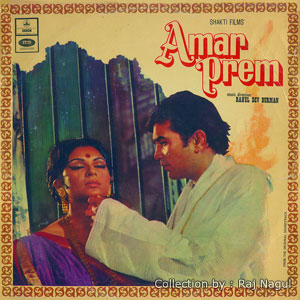Chingari koi bhadke

Film: Amar Prem (1971)
Producer and Director: Shakti Samanta
Lyricist: Anand Bakshi
Singer: Kishore Kumar
“Chingari koi bhadke” is an all-time classic from the Rajesh Khanna−Kishore Kumar−RD Burman combination. With its stirring melody, smooth, flowing rhythm and Kishore Kumar’s soulful rendition, this song has all the elements that make it one of the most distinctive and timeless creations by Pancham.
Song Melody
I’m not trained in Hindustani classical raagas but based on whatever little I know, and a bit that I’ve heard from more knowledgeable friends, the song is based on Raaga Bhairavi. But of course, this being a Pancham composition, the treatment of the melody is not bound by the structure of the raaga. There are plenty of chromatic notes (notes that are not part of the raaga or base scale of the song). For instance, in the line “to saawan usey bujhaye,” the tune of the word “usey” deliberately deviates from the original raaga. This variation gives the melody a certain melancholic flavor, which is suitable for the situation in the movie. Did you say “blues”? More about that in just a bit.
Song Meter
My definition of meter of a song is “the way in which the words flow or fit the melody” of a song. One could almost say “the rhythm of the words.” Pancham, of course, was the master of this. More often than not, in his compositions, you would find the meter where there is always a beat or two of gap. For example “Chingari koi bhadke…(gap), to sawan use bujhaaye…(gap).” Intentional or not, this was just his style, and this allowed an opportunity to use fillers like the guitar, strings, maadal, electric organ, flute, chorus, etc., which almost became part of the melody itself. Many times you end up singing that musical piece along with the melody itself. Like, “sawan jo agan lagaye, usey kaun bujhaye…tan tanan tan…usey kaun bujhaye…tan tanan tan.”
Intro Guitar Piece
The story of how the signature guitar piece of this song came about is legendary, and pretty well known. Nevertheless, here’s the YouTube link that explains the story behind one of the most recognizable guitar pieces in Hindi film music:
Rhythm Structure
There can be no doubt about Pancham’s mastery over the rhythm. As such this song is a simple 4/4 meter (Keherwa taal). However, one can see Pancham and his amazingly talented music arrangers’ artistry on full display with the rhythm pattern of this song that was created to perfectly fit the situation on-screen.
The main rhythm of the song is made up of the tabla, guiro (also known as reso reso), triangle and maadal (or a similar instrument). The four beats of the basic 4/4 pattern are broken up as follows, with continuous backing of guiro:
Beats 1 and 2 − Tabla
Beats 3 − Triangle
Beats 3.5 and 4 − Maadal
Put it together and you have the boat fluidly flowing on the Ganges with oars splashing the water in mellifluous motion. The most amazing thing about this rhythm is that it is right there in front of our own eyes, and yet, so sublime that we don’t even notice the complexity of it unless we intentionally look for it.
Hidden Gems
As is usually the case with most Pancham’s songs, there are some truly amazing hidden gems embedded in this song. By the way, some other examples are piano flourishes in “Chura liya hai (Yaadon Ki Baaraat),” guitar counters in “Do lafzon ki hai (The Great Gambler),” and so on.
In this song, listen for a small guitar counter piece in the first stanza right after “Hum se mat poochho kaise….” It is quite insignificant and yet that, I believe, is the beauty because it shows attention to detail not to leave any gap empty in arrangement.
Another hidden gem is toward the end of second stanza. During the line “Koi dushman thes lagaaye…,” check out the single note on the mandolin that plays on beat count 4. Once again, just one note, pretty insignificant and yet the song might sound empty without it.
Interesting also is the use of the flute in background harmony, in addition to strings. Everyone can provide a background with orchestral strings, but given the situation and mood of the song, the addition of the flute enhances the song’s overall effect to a new level.
Blues Influence?
I have always maintained that Pancham’s approach to a song is influenced by Jazz, Blues and other genres such as Spanish and Middle Eastern music, even though the song may be classical-based. This, according to me, is one of the reasons why his songs are prime candidates for remixes as well. The scale of “Chingari koi bhadke” and the variations in it have a distinctive blues influence. Here are a couple of videos that demonstrate the Blues influence:
https://www.youtube.com/watch?v=4SL_ubIpNyo
More often than not, when one digs deeper, peels layers, and analyzes Pancham’s songs, one discovers patterns and nuances that give a composition its distinctive RD stamp. It also gives the listener an intriguing perspective of the genius of the man − how meticulous he was in musical arrangement, innovative with his rhythm structures, breaking the barriers between classical and popular music, experimenting with sounds and unusual treatment of instruments − the list is endless. “Chingari koi bhadke” is one such quintessential R.D. Burman composition.
Pranav Jhumkhawala
panchammagic.org

